
Turn back the clock back to the evening in June 2007 in a hotel room in Charlotte, North Carolina. That was the first time I ever read Fear Agent. Conor, Josh and I were attending Heroes Con and Conor had picked up the first two trade paperbacks. Josh was reading volume 1, so I grabbed volume 2 to see what it was about. About 15 minutes later, I turned to Josh and said something along the lines of, “Holy shit, this is fantastic!” Josh heartily agreed and thus began the reign of one of the few titles so universally appreciated and loved by iFanboy.
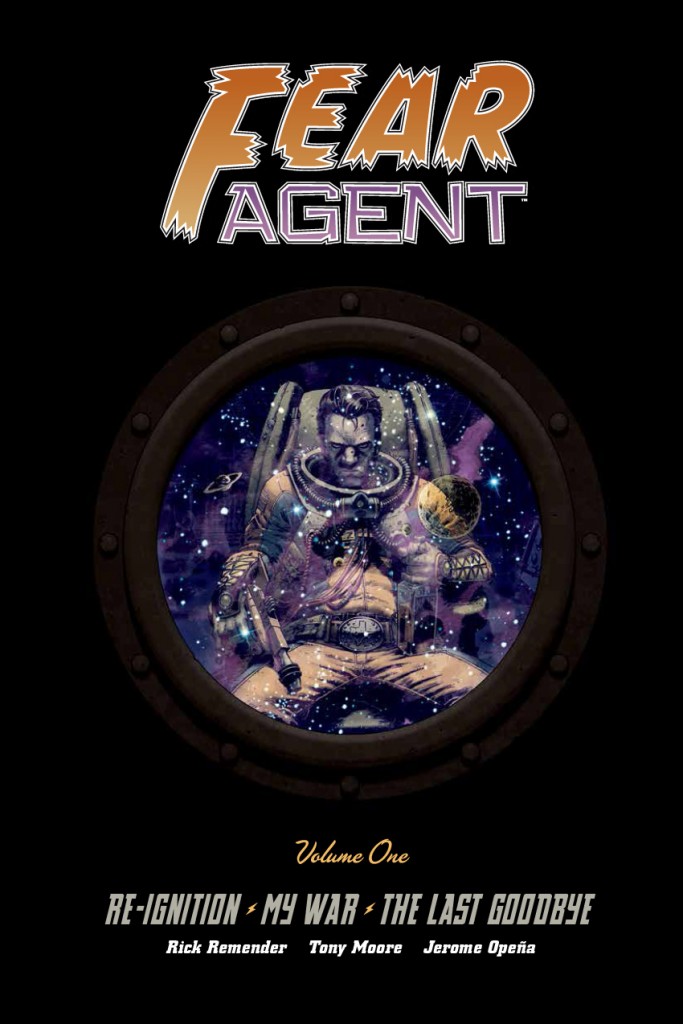 Today, almost six years later, the Fear Agent Omnibus, Vol. 1 has finally been released by Dark Horse. After wrapping up the series a year ago, I was curious what the series creators, writer Rick Remender and artists Tony Moore and Jerome Opeña, felt about the entire experience. I caught up with them a few weeks back we had a very long conversation, going back to the origins of the title, the ups and downs of the run and ultimately what it’s like to be here today, with the series wrapped and collected in a high end archival edition. What you’re about to read is the first part of three of the Oral History of Fear Agent, my little addition to the legacy of one of the finest creator owned comics of this century.
Today, almost six years later, the Fear Agent Omnibus, Vol. 1 has finally been released by Dark Horse. After wrapping up the series a year ago, I was curious what the series creators, writer Rick Remender and artists Tony Moore and Jerome Opeña, felt about the entire experience. I caught up with them a few weeks back we had a very long conversation, going back to the origins of the title, the ups and downs of the run and ultimately what it’s like to be here today, with the series wrapped and collected in a high end archival edition. What you’re about to read is the first part of three of the Oral History of Fear Agent, my little addition to the legacy of one of the finest creator owned comics of this century.
UPDATE – Yesterday, hours after the first part of this oral history went live, Dark Horse comics announced that the Fear Agent Omnibus, Volume 1 had sold out at every level. But fear not if you missed out, a second printing was also announced, shipping in April along with volume 2! So get your orders in now while you can!
Tales of The Other Fear Agent Creators
Even with Jerome Opeña joining Tony Moore, the need for fill-in artists arose and thus was born Tales of The Fear Agent, and a legendary artist coming on board in the form of Jack Davis.
Remender: Without a lot of money, and even with Jerome and Tony both putting in so many months and months of labor on the thing in order to keep it going, I think Francesco Francavilla was the first guy to come in and do a fill in issue and that was where the Tales of the Fear Agent stuff really started to take off in my head. Where in the story there were 10 years between the time Heath left Earth and the time that he was floating in space and first encountered the jelly brains.
I thought that it would be great to tell these one offs about what his life was like in those 10 years as a drunk alien exterminator and so that lent itself to putting out feelers for all kinds of amazing people to come in and pitch in stories. I think Francavilla did the first full issue that anybody else had ever drawn other than Tony or Jerome. We were able to get so many, Hilary Barta offered up his time and energy writing and drawing some backups. Paul Renaud, Steve Niles, Rafael Albuquerque, Ivan Brandon, I’m forgetting names at the top of my head. There were so many.
When we moved to Dark Horse and we were re-launching and they offered to do up some variants. Tony went out and hunted down Jack Davis which was obviously huge. I mean it’s as huge as it gets for us that Jack read the books. He wanted to read them prior to working on it and he really loved it. He gave us a really glowing quote and left a really nice message for Tony and he was just a super guy.
Moore: I don’t really like to admit it because it’s kind of creepy, but I knew basically where he lived and his name and then just kind of set out to find him on one of those snooping people finder services. I had a friend who had a paid subscription on one of them that hadn’t run out yet and so I asked him to help me out and he turned it up and I called it. I had the phone number and it took me a while to work up the courage to do it here because this guy is not only like the premiere cartoonist of the entire latter 20th century, but he is my personal artistic hero.
He was the first artist that I could recognize his work by name as a child, just by recognizing his style alone. I mean, he did everything. So for me it was a huge deal. It was like getting to meet a great ancestor that you’ve never gotten to meet or something like that, literally a huge deal for me. I sat just ringing in flop sweat, nervous, pacing around my house trying to work up the nerve to pick up the phone and call this guy. I called him up and he was super warm. He’s really friendly. He’s got this great like Fog Horn Leg Horn Georgia drawl, and he was just like the nicest guy on the planet and I felt so relieved and astounded that he would even hear me out to the end of the sentence.
He asked for some copies of the books because he wanted to make sure it was something in that he was okay contributing work to. He left me this really great phone message where he said, “I can’t believe the things you guys are doing in this book. It’s fantastic the way you guys put the stories, the way you write and draw and color and everything. It’s just so fantastic and I love it. I really wish Harvey Kurtzmann was around to see it.” He actually told me that part on the phone when I called him to thank him. I was shaking on the phone and tears coursing down my face and I was trying to keep it together so he couldn’t hear me falling apart on the other side.
That was like really as good as it gets. I called Rick and told him and he said, “Well that’s it man, just go drown yourself in the bathtub because it’s all downhill from here.”
Remender: It has been, really.
The Fear Agent Car
One year at the San Diego Comic-Con, Fear Agent got a marketing push that was unique.
Remender: Somebody at G4 was a fan of the book and they contacted Jim [Demonakos, Image Comics Marketing at the time] and they had discussed some of the upcoming promotions that they were going to be doing at the San Diego Comic-Con and Jim and G4 cooked up the Fear Agent car, which was crazy. It was giant. They took a Toyota–I think it was a Prius or something [It was a Toyota Yaris – ed.], and just covered it in images from the first issue of Fear Agent.
Opeña: Yeah, it was pretty wild. It was decked out in a full wrap with all the great images from the book. It was really bizarre. We did a signing over at the booth where they had it. They had a big fat stack of trades that they were handing out to fans. They made quite to-do over it. It was pretty exciting
The Move to Dark Horse
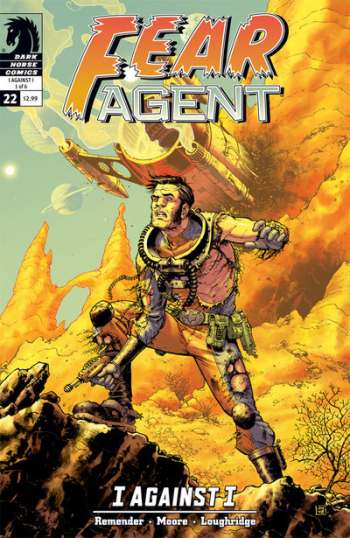 After publishing 11 issues with Image Comics, a rare change in publisher occurs.
After publishing 11 issues with Image Comics, a rare change in publisher occurs.
Remender: Around issue 10 or 11, we had hit a point where in order to keep Tony and Jerome and to keep the book alive, there was going to have to be a change. Mike Richardson [publisher at Dark Horse Comics] was a fan of the series and a couple of people had relayed to me his love for what we had done. So I had a conversation with Mike and Dave Land [Editor at Dark Horse] and they had such a passion for the series and had such a love for what we were doing, that while it was a necessity to keep the book alive, it was also a good home for the series and it fit very well over there.
We put together the first two trades over there, launched the third arc, and then got Eric Powell to do the cover for the Tales of the Fear Agent and sort of gave it a re-boost and a re-launch over there. That was where we did the next 23 issues.
Balancing Careers and Fear Agent
After working on Fear Agent and other creator-owned work, all three creators began to get work from Marvel and DC, which may have solved their personal income needs, but also affected the production of Fear Agent.
Remender: After Hatchet Job [Fear Agent, Vol. 3], which was Jerome’s second arc and the story still had in the original outline, it had broken down to like 13 or 14 more issues, to get to the end and while the trades were doing well, the singles numbers had pretty well locked in at 7,000. While I don’t think any of us were in this for the numbers, there is a financial reality to what you need to sell to be able to make a living and support yourself while doing these things. At that point we started running more Tales Of backups in the book to keep it going and we just made our minds up to work at a reduced rate and pick apart the rest of the series as we’re moving forward. The reality is that we weren’t going to stop, we weren’t going to go this far with something that we felt that passionate about and put a pin in it until we had reached the intended conclusion. Dark Horse was there and they continued to support us and to keep the book alive.
The delays were born of necessity in that we were doing other things to pay the bills and made our minds up to pick away at this thing. That was around the time that I had started doing stuff for Marvel and Jerome had just finished the Hatchet Job trade. The plan was that we would go and do some Marvel stuff, make a living, and then pick this thing apart as we could. We had a lot of help at that point with guys like Mike Hawthorne and John Lucas, who came in and carried a lot of the weight and obviously our colorist Lee Loughridge continued to do his super science on colors, so that I think that the quality of the book never diminished at any point. It didn’t have a terrific shipping schedule for sure but the more important thing to us was that it stays as good and that we crawl our way to that finish line one way or another.
For me, by the time I started doing stuff for Marvel, I have a hard enough time keeping a schedule on one book, so I think I kind of had to leave Fear Agent just so that I could focus on getting stuff done for Marvel. Unfortunately, I couldn’t work on both, which would’ve been awesome, so I just had to sacrifice working on Fear Agent just to kind of make a little bit of a living.
Opeña: I was in pretty much the same boat. I mean had the good fortune in that a lot of my stuff I was doing at Marvel was also with Rick. He was totally understanding of what I was up against but it was pretty much the same thing for me. I mean, a writer can spread themselves out a lot more easily than an artist can.
Remender: The reality of it was is that once we went to Marvel, it was just through the grace of God that we got the thing accomplished and wrapped it up at all I think. We had originally planned for Jerome to come in on that last arc and he started to care more and more about his pages and draw slower. The benefit there is obviously it’s the best looking stuff in the universe, but we did come to terms with the fact that that stuff wasn’t paying the bills We had so many things going over there [at Marvel] that I think the choice to bring in Mike Hawthorne and John Lucas to work with Tony on the final arc was by no means a sacrifice of quality.
Moore: We all kind of worked together a little bit on The Exterminators over at Vertigo, so it was a nice transition that kind of wrapped up. When I brought Lucas on to ink some of my stuff on The Exterminators, he turned in a few pages that when I looked at them, I thought “I don’t remember inking that.” Like, his inks were so much like mine that I couldn’t believe that I hadn’t done it. Then Hawthorne is just an amazing storyteller, just really great ramped up dynamics and stuff and bringing those two of them in together was really a perfect fit to just add to the pot.
The Last Issue
Once Hatchet Job was complete, it may have taken a little over 3 years to get to the finish line with the final 11 issues, but they were able to wrap it and send Heath Huston off into the sunset.
Remender: When we were working on Fear Agent, Jerome lived in San Francisco as well and he lived not too far from me. He would come into the studio, I would have the scanner, and we would scan up pages, and talk story. I had started a notebook around that time where I would just write down ideas that we had talked about and then Tony and I would get on the phone and do the same thing where we would just talk, talk, talk out ideas and volley things back and forth. I think that we had all kind of had various ideas of how we would put Heath in the ground at the end of this thing and I don’t remember where the riding off into the sunset thing came from. I hate to take credit for ideas even if their mine, I don’t know, but that was sort of what happened.
Moore: It was too good, it couldn’t have been yours (laughs).
Remender: That was written in my notebook pretty early on that in the last issue, he rides off into the sunset and I think that as I was putting together that final issue or that final outline, when I got to that point in the note, I was like that’s how we wrap it. You know he doesn’t just ride off into the sunset. He rockets off into the sun.
Again, the point of the series was so much about Heath and his tenacity and his struggle to try and to make normal what had become destroyed. His family and Earth and all of these things and getting to tell that part of the story while it was a downbeat because he died–I guess you should put a big spoilers thing over this–because it was a down ending and he died but it was still like sad to see the character go but I felt like we also gave him such a big win in resetting everything that it had a nice balance to it.
Tune in tomorrow for part 3, where we hear about the fans of Fear Agent, the Omnibus, the creators’ final thoughts and more from the Oral History of Fear Agent
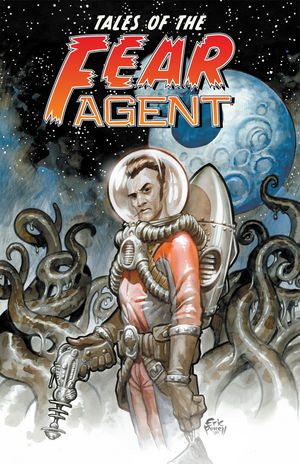

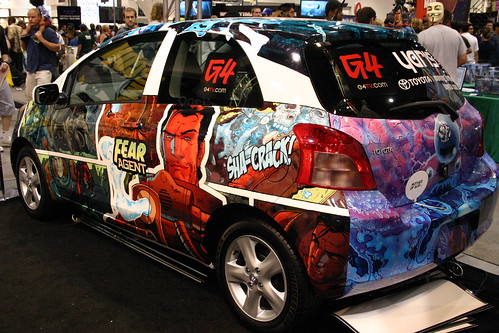
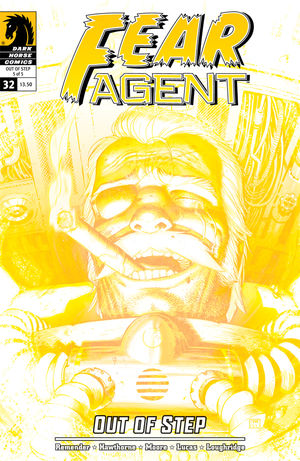


I actually got a nice little surprise today from Amazon saying that I would get a copy in a week’s time
Question: Anyone know where the Mark Twain quote from the end of the last issue come from? It’s such a beautiful quote
Not sure which quote that was, I don’t quite remember. Just plug it into Google though and it will answer your question. So many great Twain quotes in this series.
Amazon claims they will have these in stock Monday. I’d recommend looking there before waiting until April.
http://www.amazon.com/Fear-Agent-Library-Volume-1/dp/1616550058/ref=sr_1_1?ie=UTF8&qid=1355438743&sr=8-1&keywords=fear+agent+hc
Is this series available digital?
You’d have to check Dark Horse’s app, but I wouldn’t recommend buying digital from Dark Horse because their digital app is so bad.
They don’t have it. Thanks for the advice though. I really want to read this so I might have to just break down and buy a paper copy. Shitty
Dark Horse made the series available digitally this week, I believe. https://digital.darkhorse.com/browse/162/
Just got the first two volumes. Thanks for the tips.
Great oral history for this series, ron !! I wasn’t aware that the 1st 11 issues were done for image. I picked up the omnibus today !! Looking forward to getting into it